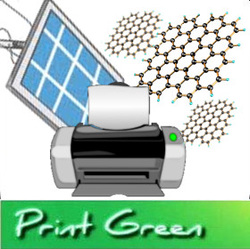
Inkjet printers are not just for conventional printing, and this has been proven years ago. From its basic function to print text, images and graphics either mono or color, it's main purpose evolve into something more unusual. Let's admit it, researchers and developers are really good at this, surprising us with their inventions and breakthrough that brought us to this new world.
In the year of 2008, Konarka Technologies, developed a printable solar panel film which can be used for photovoltaic solar panels. With the use of an inkjet printer they were able to produce solar panels as thin as a plain paper sheet through common inkjet printing process. Konarka developers replaced the ink that we commonly used in our everyday printing needs, with solar cell materials, while the sheet from where these matters will be printed are not just a typical paper sheet but a special and flexible plastic substrate. It became a hit since printed solar cells are way cheaper than silicon panels, however the option to release it for the masses is not considered yet.
Konarka's breakthrough was followed by another discovery from MIT Discoveries. Production and installation of solar panels are normally expensive, thus, once an alternative came into the consumer's view it will surely make a hype. That's what the MIT Researcher's figured out, a way from which solar cells can be printed onto paper materials using the printing process similar to an inkjet printer. The invention was called semiconductor-coated paper that features a carbon-based dyes that improved the solar cells efficiency by up to 2%.
As the most recent update regarding the application of inkjet printing, Max Plank Institute Of Colloid and Interfaces in Potsdam-Golm had a group of researchers which was led by Cristina Giordano, that was able to utilized paper sheets to produce conductive structures. Again with the use of an inkjet printer, they made it successful to deposit catalyst on sheets of paper and by simply applying heat into the surface, it eventually turn into a graphite capable of conducting electricity.
In the year of 2008, Konarka Technologies, developed a printable solar panel film which can be used for photovoltaic solar panels. With the use of an inkjet printer they were able to produce solar panels as thin as a plain paper sheet through common inkjet printing process. Konarka developers replaced the ink that we commonly used in our everyday printing needs, with solar cell materials, while the sheet from where these matters will be printed are not just a typical paper sheet but a special and flexible plastic substrate. It became a hit since printed solar cells are way cheaper than silicon panels, however the option to release it for the masses is not considered yet.
Konarka's breakthrough was followed by another discovery from MIT Discoveries. Production and installation of solar panels are normally expensive, thus, once an alternative came into the consumer's view it will surely make a hype. That's what the MIT Researcher's figured out, a way from which solar cells can be printed onto paper materials using the printing process similar to an inkjet printer. The invention was called semiconductor-coated paper that features a carbon-based dyes that improved the solar cells efficiency by up to 2%.
As the most recent update regarding the application of inkjet printing, Max Plank Institute Of Colloid and Interfaces in Potsdam-Golm had a group of researchers which was led by Cristina Giordano, that was able to utilized paper sheets to produce conductive structures. Again with the use of an inkjet printer, they made it successful to deposit catalyst on sheets of paper and by simply applying heat into the surface, it eventually turn into a graphite capable of conducting electricity.
Source : Inhabitat
"To fabricate their electronics, the Potsdam researchers converted the cellulose in paper into graphite by using an iron nitrate catalyst laid down by a commercial inkjet printer. After being heated to 800 degrees Celsius in a nitrogen atmosphere, the cellulose expelled water until all that was left was pure carbon. These areas become conductive, while the non-printed areas are less able to move electrons."
As it seems, inkjet printing technology can also be utilized in the field of carbon electronics. Although these inventions are not to be purposely commercialized, it's quite considerable since these breakthrough are still on their research phase. Ink cartridges on the other hand aren't left behind. Unlike with printer toner cartridges, aside from the fact that alternatives such eco-friendly toner cartridges are commonly available, breakthroughs aren't feasible yet. Whereas with inks, there were a few researches like solid inks and bio-based inks that may lead to such innovations where we could hope commercialization is not just an option.
 RSS Feed
RSS Feed